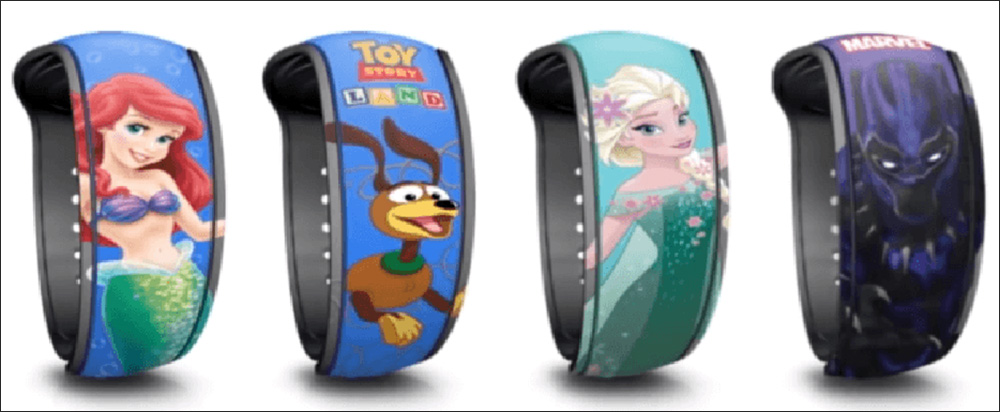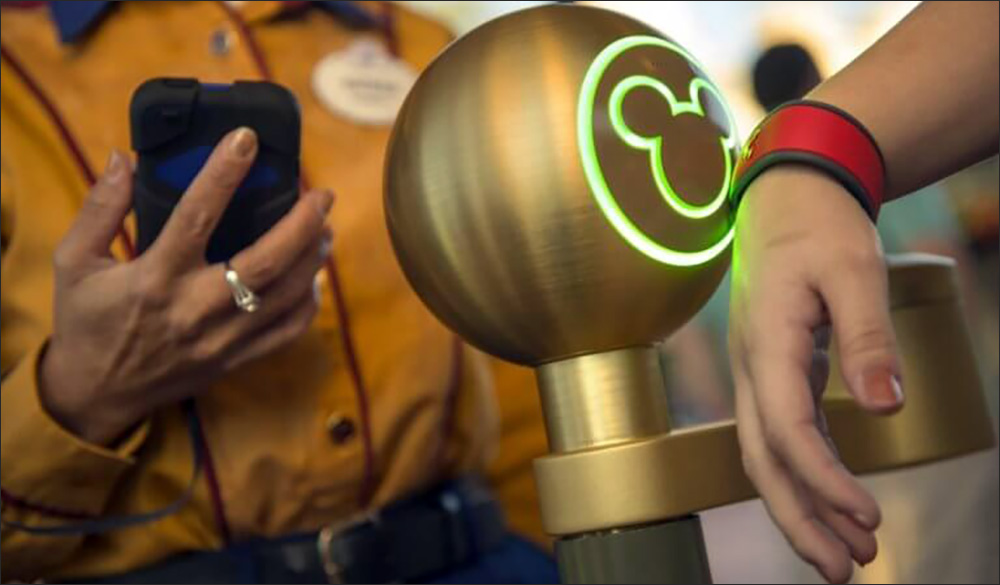Not long after the COVID-19 pandemic began, Walt Disney World announced that it would no longer be taking orders for the RFID-enabled MagicBand slap bracelets it issues to guests so they can gain park and ride access, as well as purchase food, beverages, memorabilia and other goods. The various Disney parks closed in March 2020 with the goal of reopening in April, though that plan fell through as the coronavirus spread in alarming numbers, resulting in the parks remaining closed for a more extended span of time, during which the MagicBands were unavailable to Disney fans.
According to a report from WDW News Today, the MagicBands are now back in Disney stores, featuring such characters as Figment (the mascot of EPCOT’s Imagination! pavilion), Orange Bird (a Florida Citrus Commission mascot that appears in Magic Kingdom’s Enchanted Tiki Room), Stitch (of Lilo and Stitch fame) and Olaf (from the Frozen films), along with longtime Disney staples Mickey Mouse and friends. Radio frequency identification is still built into the bracelets, indicating the company has fixed problems it reportedly had with RFID that had caused it last year to pull the MagicBands from its shelves. Innovation rarely stagnates at Disney, and the bands may soon give way to newer technologies based around the ubiquitous smartphone.

Disney unveiled the wristbands at its theme parks in spring 2014, when it began providing the dual-frequency (13.56 MHz and 2.4 GHz) MagicBands to all resort guests who booked a Walt Disney World hotel reservation. The bracelets let visitors access services reserved through its Web-based My Disney Experience system. All entrance points to the park, all rides and events, and all Disney hotel rooms and point-of-sale locations are equipped with high-frequency RFID readers to read the bands’ tags, making the customer experience quicker and more fun by reducing queues and the need to carry cash, tickets and IDs (see MagicBands Bring Convenience, New Services to Walt Disney World).
The unveiling followed a 2013 New York Times article discussing Disney’s plans for the wristbands (see At Disney Parks, a Bracelet Meant to Build Loyalty [and Sales]). That article drew concern from Congressman Ed Markey, who put out a rather alarmist press release indicating he’d “raised questions today about the privacy implications for children visiting Disney theme parks resulting from the company’s plan to offer a new bracelet at its parks that will serve as a payment source, room key and gateway to other services during visits to some Disney parks” (see Grilling Disney Over the Use of RFID). Markey’s fears proved unfounded, of course, and the MagicBands rolled out as planned.

In short order, the bracelets began featuring a wide variety of characters, and they’ve became popular collector’s items among frequent park visitors. Guests could choose a complimentary MagicBand with a solid color, or they could pay for an upgrade to one featuring Minnie Mouse, Disney Princesses, Toy Story characters or other Disney cast members. Many such designs have since been added to the mix. Not surprisingly, the company recently added a Star Wars “baby Yoda” version of the RFID wristbands, capitalizing on the success of the Disney+ and Lucasfilm series The Mandalorian.
In June of this year, InsidetheMagic.com reported that Disney plans to discontinue its practice of offering complimentary bands—though fans can still purchase them if they so desire—so that it could roll out a new system involving smartphones as part of the My Disney Experience app. Disney put out the following statement explaining its decision to do so:
“As you begin planning your upcoming visits, we’re also exploring engaging ways for guests to use their mobile tech to experience the magic—particularly now as the use of phones and apps continues to evolve. In 2021, we plan to unveil an innovative new offering as part of the My Disney Experience app that will bring features of a MagicBand to your smart devices, building on the app’s existing digital key feature. With this new offering on the horizon, we will be retiring our complimentary MagicBand distribution to Disney Resort hotel guests for new reservations with arrivals beginning Jan. 1, 2021. Disney Resort hotel guests will continue to have the option to purchase new MagicBands at a discount, and we’ll be introducing even more colors and designs featuring favorite Disney characters in the future. Guests who prefer not to purchase a discounted MagicBand will be able to use the My Disney Experience app or a Key to the World card during their visit. We will still offer MagicBands in retail locations and on shopDisney.com, and guests will be able to continue using the wearables throughout Walt Disney World Resort.”

Beyond the use of wristbands, Disney has long seen the value of RFID technology, going back to 2009 when the entertainment giant began investing in upgrading its stores, with RFID greatly improving the customer experience (see Disney Gets It). Three years later, it began using passive UHF RFID tags to track $100 million worth of costumes at its parks and on its cruise ships, making garment issuance a self-serve process. The system improved the visibility of costumes during its laundering and repair processes, and it also reduced the amount of time required to perform inventory counts. An increase in job satisfaction was an unexpected benefit, since park personnel found that the technology made things easier for them (see RFID Helps Disney Employees Get Into Character).
In 2016, the company’s lab network, together with scientists from MIT, the University of Washington and Carnegie Mellon, developed systems with which it could enable robots to better identify individuals, as well as track everyday interactions between people and things. Disney Research published academic papers describing such novel uses of RFID, and the company also spoke at that year’s RFID Journal LIVE! conference and exhibition (see Disney Research Explores Ways to Add RFID Intelligence to Robots, Toys). So its use of the RFID-enabled MagicBands was a natural development, as Disney has always been at the forefront of innovation.
With news of the MagicBands’ decreased prominence, it will be interesting to see how the House of the Mouse will employ radio frequency identification and similar technologies down the line. Founder Walt Disney famously said “All our dreams can come true if we have the courage to pursue them,” as well as “Get a good idea and stay with it. Dog it and work at it until it’s done right.” Disney had a good idea with its MagicBands, it had the courage to pursue the dream of automated park access and cashless purchases, and as it now transitions from wristbands to smartphone apps, it has shown its great capacity to work at something until it’s done right. I have a feeling that were he alive today, ol’ Walt would approve.
Rich Handley has been the managing editor of RFID Journal since 2005. Previously, he was the managing editor of Advanced Imaging magazine and the associate editor of Printing News. Rich has authored, edited or contributed to numerous books about pop culture and is also the editor of Eaglemoss’s Star Trek Graphic Novel Collection.

